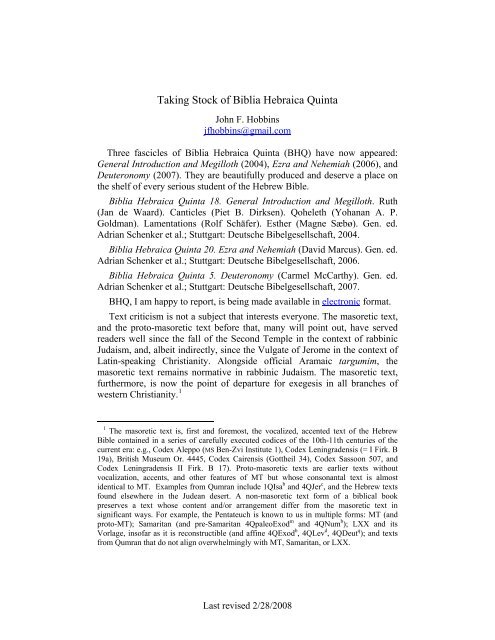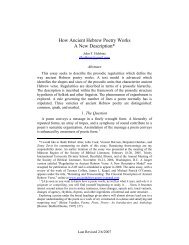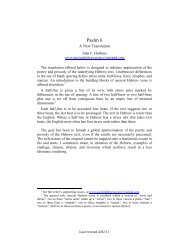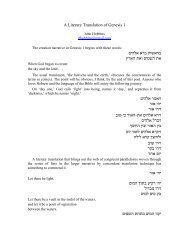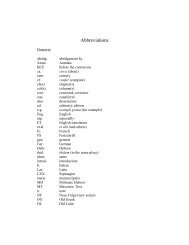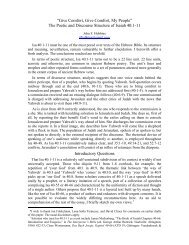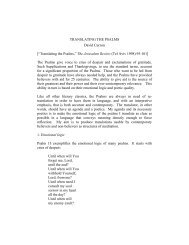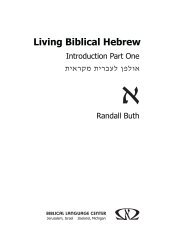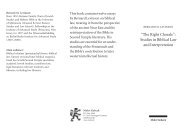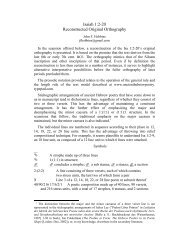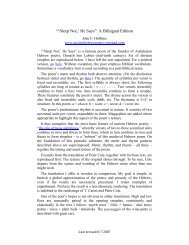Whither Biblia Hebraica Quinta - Ancient Hebrew Poetry
Whither Biblia Hebraica Quinta - Ancient Hebrew Poetry
Whither Biblia Hebraica Quinta - Ancient Hebrew Poetry
- No tags were found...
Create successful ePaper yourself
Turn your PDF publications into a flip-book with our unique Google optimized e-Paper software.
Taking Stock of <strong>Biblia</strong> <strong>Hebraica</strong> <strong>Quinta</strong>John F. Hobbinsjfhobbins@gmail.comThree fascicles of <strong>Biblia</strong> <strong>Hebraica</strong> <strong>Quinta</strong> (BHQ) have now appeared:General Introduction and Megilloth (2004), Ezra and Nehemiah (2006), andDeuteronomy (2007). They are beautifully produced and deserve a place onthe shelf of every serious student of the <strong>Hebrew</strong> Bible.<strong>Biblia</strong> <strong>Hebraica</strong> <strong>Quinta</strong> 18. General Introduction and Megilloth. Ruth(Jan de Waard). Canticles (Piet B. Dirksen). Qoheleth (Yohanan A. P.Goldman). Lamentations (Rolf Schäfer). Esther (Magne Sæbø). Gen. ed.Adrian Schenker et al.; Stuttgart: Deutsche Bibelgesellschaft, 2004.<strong>Biblia</strong> <strong>Hebraica</strong> <strong>Quinta</strong> 20. Ezra and Nehemiah (David Marcus). Gen. ed.Adrian Schenker et al.; Stuttgart: Deutsche Bibelgesellschaft, 2006.<strong>Biblia</strong> <strong>Hebraica</strong> <strong>Quinta</strong> 5. Deuteronomy (Carmel McCarthy). Gen. ed.Adrian Schenker et al.; Stuttgart: Deutsche Bibelgesellschaft, 2007.BHQ, I am happy to report, is being made available in electronic format.Text criticism is not a subject that interests everyone. The masoretic text,and the proto-masoretic text before that, many will point out, have servedreaders well since the fall of the Second Temple in the context of rabbinicJudaism, and, albeit indirectly, since the Vulgate of Jerome in the context ofLatin-speaking Christianity. Alongside official Aramaic targumim, themasoretic text remains normative in rabbinic Judaism. The masoretic text,furthermore, is now the point of departure for exegesis in all branches ofwestern Christianity. 11 The masoretic text is, first and foremost, the vocalized, accented text of the <strong>Hebrew</strong>Bible contained in a series of carefully executed codices of the 10th-11th centuries of thecurrent era: e.g., Codex Aleppo (MS Ben-Zvi Institute 1), Codex Leningradensis (= I Firk. B19a), British Museum Or. 4445, Codex Cairensis (Gottheil 34), Codex Sassoon 507, andCodex Leningradensis II Firk. B 17). Proto-masoretic texts are earlier texts withoutvocalization, accents, and other features of MT but whose consonantal text is almostidentical to MT. Examples from Qumran include 1QIsa b and 4QJer c , and the <strong>Hebrew</strong> textsfound elsewhere in the Judean desert. A non-masoretic text form of a biblical bookpreserves a text whose content and/or arrangement differ from the masoretic text insignificant ways. For example, the Pentateuch is known to us in multiple forms: MT (andproto-MT); Samaritan (and pre-Samaritan 4QpaleoExod m and 4QNum b ); LXX and itsVorlage, insofar as it is reconstructible (and affine 4QExod b , 4QLev d , 4QDeut q ); and textsfrom Qumran that do not align overwhelmingly with MT, Samaritan, or LXX.Last revised 2/28/2008
3refer to as the masoretic text, is not thereby diminished. The first translatorsof the books of the <strong>Hebrew</strong> Bible into Greek; the scribes and readers of4QJosh a , 4QSam a , 4QJer b , and 4QJer d ; Jewish authors of the caliber of Philoand Josephus; and Christian authors of the caliber of the authors of Matthewand <strong>Hebrew</strong>s, heard God speak to them through non-proto-masoretic texts intheir possession. It is not impossible, should we choose, to do likewise.BHQ aims to describe “the earliest attainable form(s) of the text” of the<strong>Hebrew</strong> Bible “based on the available evidence” (General Introduction,XV). That ought to include, in a host of cases, non-proto-masoretic forms ofthe text. In this essay, I examine the degree to which the fascicles publishedso far acquit themselves in this respect. Along the way, I offer reflections onthe whither and wherefore of text criticism of the <strong>Hebrew</strong> Bible.PreliminariesFor an introduction to BHQ which complements the one provided in BHQ18, I refer the reader to an essay by one of BHQ’s editors, Richard D. Weis.It appeared in TC 7 (2002) [= TC: A Journal of Biblical Textual Criticism].Typos and stylistic infelicities in the published fascicles are few and farbetween. The editorial committee invites readers to submit lists of observederrors to a designated electronic address: bhq@dgb.de.BHQ is the successor project of <strong>Biblia</strong> <strong>Hebraica</strong> Stuttgartensia (BHS). Itremains a diplomatic edition of a single medieval manuscript, CodexLeningradensis, to the point that obvious errors in the codex are nowreproduced in the body of the edition and only corrected in footnotes. It isalso a new product with a number of innovative features. An obvious BHQimprovement vis-à-vis BHS is that run-on lines, with overflow text placed onthe line above or below and preceded by a bracket, have been eliminated.In the following, five aspects of BHQ serve as springboards for widerrangingreflections: (1) production schedule; (2) format; (3) treatment ofpoetry; (4) updateability; and (5) advantages and disadvantages vis-à-vis aparallel project, OHB. The critical remarks I offer are not meant to diminishthe massive achievement BHQ to date represents.Production ScheduleBHQ was originally scheduled for completion between 2005 and 2007.Three fascicles have so far appeared, with others sure to appear before long.It is now stated that the project will reach completion by 2010. It seems morelikely that it will not be completed until 2012 at the earliest.
4How does that compare to the production schedules of three relatedprojects of interest to students of the <strong>Hebrew</strong> Bible?The <strong>Hebrew</strong> University Bible Project (HUBP) is the collaborative effortof a team of Israeli scholars. At base it is a diplomatic edition of a singlemedieval manuscript, Codex Aleppo. A massive number of variants from avariety of sources are collected in a multi-tiered apparatus, with limiteddiscussion thereof.Two of the finest scholars in the field served in succession as generaleditor of HUB: Moshe H. Goshen-Gottstein and Shemaryahu Talmon. Asample edition of a portion of the book of Isaiah appeared in 1965, thedefinitive “Part One Part Two” of Isaiah [Isa 1-22] in 1975, volume 2 [Isa22-44] in 1981, and volume 3 [Isa 45-66] in 1993. Jeremiah appeared in1997, Ezekiel in 2004.After a 50-year run, rumor has it the project is now defunct. Perhapsmoney is the issue. The other issue is bound to hinge upon whom the mantleof Elijah shall be bestowed after Talmon. Whoever that might be wouldneed, like Elisha, a double portion of the spirit to carry on. HUBP’s webpageleaves us in the dark about its future.Mikraot Gedolot HaKeter is under the editorship of Menachem Cohen. Itis another Israeli endeavor, this time out of Bar-Ilan University. For moredetailed information on this exciting project, go here.The latter project is not nearly as well-known as it deserves to be. Thevolumes contain an extremely accurate <strong>Hebrew</strong> text based on Codex Aleppoand, where Codex Aleppo is not preserved, other early medieval mss. It alsocontains the notes of the masorah parva and masorah magna with case-bycaseexplanations; Targum Onkelos or the Targum to the Prophets accordingto a critical edition that supersedes all previous editions; and texts of thegreat commentary tradition of Rashi, Kimchi, Ibn Ezra, and others based onthe best extant mss., not print editions. All components of HaKeter arepresented in an easy-to-read format.The most obvious gifts HaKeter makes to the text criticism of the <strong>Hebrew</strong>Bible are its critically established Targum texts. For a handy guide to thebest critical editions of the Targumim, see the notes in CAL here. It is ofinterest that the texts chosen for CAL in the case of Targum for Qohelethand the Targum for Ruth are not the same as those chosen by BHQ.Collation of the texts chosen for CAL makes sense in preparation for thedefinitive edition of BHQ.
6accurate Masoretic text. At the same time, a long string of conjecturalemendations are deemed worthy of inclusion in the textual footnotes to theEnglish translation. The notes relate in the first instance to the <strong>Hebrew</strong> text.Other conjectural emendations are reflected in the translation without anaccompanying footnote.It might have been better if NJPSV translated MT as graciously aspossible even when the text is in apparent disorder, and relegate a translationof the text as it seems best to reconstruct it to a footnote. Moshe Greenbergargued this point. 4But it must be admitted that the production of an unadulterated translationof MT poses challenges of its own. Greenberg, to be sure, showed the way.In his Ezekiel commentary, he offers a translation which is unintelligiblewhen MT is unintelligible. 5 For example, Greenberg translates Ezek 11:21aas follows: ‘But those whose hearts go after their heart-of-loathsome-andabominablethings’ (186). He footnotes the fact that the <strong>Hebrew</strong> is strained,and offers a conjectural emendation as a remedy. The remedy is defended inthe comment (191).From a text critical point of view, at a minimum one might wish that atranslation of MT would footnote every case in which it disregards its basetext in favor of an alternative, including every instance in which thevocalization of the consonantal text and/or the syntactic construal MTpreserves is overridden. If this were done, the need for text criticism in theseinstances would be immediately obvious. By definition, each footnoted locuswould constitute a text critical flashpoint.This is not to say that every rough patch in MT by definition requires textcritical attention, or that smooth passages never do. In the case of smoothpassages, it is usually impossible to guess when a scribe cleaned up adifficult passage unless a non-masoretic witness to the text points in thatdirection. To this extent, but to this extent only, I concur with paragraph 31in Weis’s essay in which he defends the decision not to discuss passagesbecause a surviving textual witness does not exist that attests to the correctreading. I disagree. On the face of it, even examples for which a text critical4 Moshe Greenberg, “The New Torah Translation,” Judaism 12 (1963) 226-237; repr. withadditional note in idem, Studies in the Bible and Jewish Thought (JPS Scholar of DistinctionSeries; Philadelphia: The Jewish Publication Society, 1995) 245-260.5 Moshe Greenberg, Ezekiel 1-20: A New Translation with Introduction and Commentary(AB 22; Garden City: Doubleday, 1983); Ezekiel 21-37: A New Translation withIntroduction and Commentary (AB 22A; Garden City: Doubleday, 1997).
7solution is obvious ר/ד) interchanges, etc.) will be left unsolved by BHQ if asurviving textual witness attesting to it does not exist.To return to the example of Ezekiel: unless someone is simply tone-deafto what Ezekiel is likely to have said in his day, and to what his editor, whomay have been himself, is likely to have written down, it is impossible not tocorrect MT Ezekiel in a number of instances, with or without the support ofan extant variant reading.If this is the case, BHQ’s narrow focus is ultimately in need of acorrective.The Goal of Text Criticism of the <strong>Hebrew</strong> Bible:A Reconstruction of proto-MT or multiple early text Forms?To continue with the example of Ezekiel, it might seem that areconstruction of the text as it might have appeared at some point in timebefore or apart from the standardization of the text reflected in MT, is not aconcern of the BHQ team. On this view, OG Ezekiel, which witnesses to ashorter and probably earlier recension of the text, might safely be set to oneside. Those who have read Barthélemy might be tempted to think so. 6In point of fact, it cannot be said that the BHQ editors are in lock-stepagreement with Barthélemy’s approach to the text criticism of the <strong>Hebrew</strong>Bible.Schäfer’s edition of Lamentations may illustrate. Schäfer is not averse topreferring a text that deviates from MT based on the testimony of non-proto-MT textual witnesses. His discussion of Lam 1:7 is a case in point. He optsfor a text that is in part based on 4QLam and in part based on conjecturalemendation.I would defend a text far closer to MT than Schäfer does at Lam 1:7. 7 ButI applaud his willingness to prefer a text at odds with MT if evidence andreasoning point him in that direction.6 That OG Ezekiel reflects the existence of a separate edition of the book is apresupposition of the text-critical discussions of MT Ezekiel in Dominique Barthélemy, ed.,Critique textuelle de l’Ancien Testament 3: Ézéchiel, Daniel et le 12 Prophètes (OBO 50/3;Fribourg/Göttingen: Éditiones Universitaires/Vandenhoeck & Ruprecht, 1992). As such therole it plays in text critical determinations made by Barthélemy’s team, relating as they do tothe edition of the book reflected in MT Ezekiel, is minimal.7 For an alternative to Schäfer’s preferred text at Lam 1:7, see the present writer’s “InSearch of Prosodic Domains in <strong>Ancient</strong> <strong>Hebrew</strong> Verse: Lamentations 1-5 and the ProsodicStructure Hypothesis” (2006) ad loc (here).
10editions. The Handausgabe of MT I would wish to have is different from theone that is contemplated. I provide details in the next section.Treatment of <strong>Poetry</strong>According to James Sanders in his review of BHQ 18, “Another highlycommendable trait of BHQ is that of presenting the text honoring thete’amim or masoretic accent marks.” 9 Would that this were true.Instead, the editors still go about deciding when a text unit is poetry andwhen it is not, and then give their interpretation of its stichometry, not that ofMT. For example, Schäfer trisects Lam 1:1 where MT bisects it. Schäfer isright to do so, but that is beside the point. Either an edition of MT honors theprosodic implications of the neumes MT preserves, or it does not. BHQ doesnot. That is, it does not always do so.The problem reappears in BHQ Jeremiah, of which Weis offers a samplepage. Jer 23:5-6 and 9 are treated as poetry, Jer 23:1-4, 7-8 are not. Onceagain, an editor’s opinion intrudes into what is otherwise a faithful edition ofCodex Leningradensis. The codex does not register a distinction betweenprose and poetry in Jeremiah. Neither should a diplomatic edition of it.My dream Handausgabe of Codex L would include the followingcomponents: an introduction to and contextualization of L at the crossroadsbetween Karaite and Rabbanite Judaisms; a diplomatic edition of L, witheditorial decisions about poetry and stichometry eliminated; a glossary ofterms for the masorah parva; a table of accents and an introduction to themas a representation of recitative prosody; a multi-tiered apparatus (variantreadings attested in other carefully executed Masoretic codices; in the massof medieval manuscripts; in rabbinic literature; the Vulgate, Targum, andPeshitta (where proto-masoretic); and in proto-masoretic texts from theJudean desert); introductions to the books limited to a discussion of theaforementioned witnesses; and notes on the masorah parva and masorahmagna. All MT and proto-MT, all the time.A dream companion volume would include the following: the earliesttext(s) attainable based on the available evidence, if necessary on facingpages, with editorial decisions about poetry, stichometry, and other unitdelimitations included; an apparatus containing a full account of significantvariants attested in the ancient versions, the texts from the Judean desert,rabbinic literature, and medieval biblical manuscripts; commentary thereto,and introductions to the books covering all the text traditions.9 James A. Sanders, review of BHQ 18, RBL 5 (2005).
11Still another desideratum: a volume that presents the texts without thefamiliar orthography, vocalization, syntactic and prosodic representations,unit delimitations, and mise en page of MT. Only in the presence of theabsence of these features is the student of the text alerted to alternativeconstruals of the text that were avoided in the interpretative traditions thathave come down to us (almost always rightly avoided, but the otheroperative word here is almost).No, my name is not Joseph, but perhaps this dream will come true, orsomething like it, some day.UpdateabilityThe issue of updateability is a pressing one given the pace of progress inthe field of text criticism of the <strong>Hebrew</strong> Bible. It is understandable that a textcritic might do his or her work with great care and yet fall short of fullyengaging with the relevant secondary literature.The volume dedicated to Ezra-Nehemiah edited by David Marcus mayserve to illustrate. It is undoubtedly a piece of exemplary scholarship, but itis cause for astonishment that interaction in its pages with thegroundbreaking work of Dieter Böhler is limited to signaling disagreementwith Böhler’s main thesis, to wit: “Gα reflects a <strong>Hebrew</strong> Vorlage earlier thanthe MT” (10*). 10 Marcus, as is his prerogative, concludes otherwise, but adiscussion of the pros and cons of the Mowinckel-Pohlmann-Böhler schoolof thought (the relevant contributions of Mowinckel and Pohlmann are noteven registered by Marcus), in general and on a case-by-case basis, wouldhave made the textual commentary immensely more valuable than is now thecase.This is part of a larger pattern of avoidance which bedevils the volume.Loci which cry out for text-critical comment and are discussed at length inthe major commentaries (Rudolph, Williamson, Blenkinsopp, and Clines)are liquidated in short order or passed over in silence. The result is that BHQ20 is of marginal interest to the text-critical study of Ezra-Nehemiah.10 Böhler, it might be noted, goes on to posit a second century BCE date for the recensionof Ezra-Nehemiah reflected in MT (idem, “On the Relationship between Textual andLiterary Criticism. The Two Recensions of the Book of Ezra: Ezra-Neh (MT) and 1 Esdras(LXX),” in The Earliest Text of the <strong>Hebrew</strong> Bible. The Relationship between the MasoreticText and the <strong>Hebrew</strong> Base of the Septuagint Reconsidered [ed. Adrian Schenker; SBLSCS52; Atlanta: Society of Biblical Literature, 2003] 35-50; 48). This tallies with research fromvarious quarters which posits the creation of revised editions of other biblical books in thiscentury.
12This is not acceptable. Between now and the issuance of the editio maior,Marcus would do the field a service if at a minimum he added to his volumean extended discussion of the following passages: (the reconstructed Vorlageof) 1 Esd 2:23 / Ezra 4:21; 1 Esd 5:45 / Ezra 2:70; 1 Esd 5:46 / Ezra 3:1; 1Esd 6:8 / Ezra 5:8; 1 Esd 7:9 / Ezra 6:18; 1 Esd 8:78 / Ezra 9:9; 1 Esd 8:88 /Ezra 10:1; and 1 Esd 9:1 / Ezra 10:6.A set of analogical observations might be advanced in the case of Sæbø’streatment of Esther in BHQ 18. According to Sæbø, G AT is a redaction of theG text. He is entitled to his view. But Clines, Fox, and Jobes, who argue thatG AT is a translation of a <strong>Hebrew</strong> Vorlage, are no less entitled to theirs. So isTov, who argues that it is a recension of a pre-existing translation towards a<strong>Hebrew</strong> text. This being the case, the decision not to systematically recordvariant readings from G AT is unconscionable. The evidential basis on whichSæbø reached his conclusion, Tov his, and Clines, Fox, and Jobes theirs isnot given to us.A synoptic comparison and full presentation of early editions of Qohelethand Canticles for which we have evidence is also in order. I explain why inthe following paragraphs. If this is not practical in the print edition of BHQ,it might be offered in an online extension.Goldman makes a persuasive case for the view that in “a number ofplaces,” MT “attests a revision to soften Qoheleth’s criticisms addressed tothe ‘wise’ and the ‘righteous’ (e.g., 7:19: [sic] 8:1)” (BHQ 18, 76*). A userfriendlyversion of this statement would consist of a concise presentation ofall instances of ideological revision, with full citation of the evidence andreconstructed <strong>Hebrew</strong> Vorlagen.“[A]s Tov has demonstrated,” Dirksen notes, both 4QCant a and 4QCant breflect abbreviated editions of the book of Canticles (BHQ 18, *10). Theseearly alternative editions of Canticles merit a full presentation. It is true thatTov is the closest thing to the oracle of Delphi the field of text criticism ofthe <strong>Hebrew</strong> Bible has, but a summary of Tov’s arguments, not just a barestatement of his conclusion, would have been helpful. A more adequateintroduction to and presentation of the Qumran Canticles evidence is foundin another reference work, but in English translation only. 1111 Martin Abegg, Jr., Peter Flint, and Eugene Ulrich, ed., The Dead Sea Scrolls Bible. TheOldest Known Bible Translated for the First Time in English (New York: HarperCollins,1999) 612-18.
13BHQ Qoheleth and Canticles are less useful than they might be becauseconjectural emendations with a high degree of plausibility from a text criticalpoint of view are not discussed. Two examples may illustrate.The difficulties of Qoh 2:12 are examined at length by Goldman (*72-*73). A conjectural emendation of Budde is duly noted but rightly rejected.י/ו However, the revocalization of two words proposed by Ginsberg and theinterchange in another word suggested by Fox are left unmentioned. Theplausibility of these suggestions from a text critical point of view, unlikeBudde’s, is indisputable. They merit discussion.Cant 3:10-11 in the extant witnesses is problematic. Emendations offeredby Graetz and Gerleman are plausible from the text critical point of view andpersuasive from a literary and stylistic point of view. They are adopted byFox and Exum. 12 Without alerting their readers to the fact, a number ofrecent translations emend similarly, in whole or in part (NRSV, REB, NAB,NJB; NJPSV emends also, in a footnote). Silent emendation, of course,should be forbidden, even if the emendation seems obvious. Dirksen’sdecision to silently omit reference to the problems the emendations addressis likewise indefensible.Dirksen also fails to discuss loci of text-critical interest for whichdivergent extant witnesses exist. For example, at Cant 8:13, the prosodicdivisions of MT are reproduced, with the final word of the verse bereft of acompanion. This is laudable. On the other hand, Fox argues in favor of analternative division of the verse. He cites V in support. This is probablycorrect. 13 The locus merits discussion in the apparatus and comment.Quite apart from the issues raised here, an online edition to BHQ is adesideratum. BHQ’s usefulness would be enhanced if the online editionincluded discussions of loci like those alluded to in this review.BHQ vs. OHB: A ComparisonBHQ Deuteronomy 31:28-32:47 immediately strikes the eye of anyonewho has worked directly with Codex Leningradensis (L). L’s layout is notrespected in BHQ 5. McCarthy claims to reproduce the format prescribed inan extracanonical tractate of the Talmud entitled Masseket Soferim. 14 But so12 Michael V. Fox, The Song of Songs and the Egyptian Love Songs (Madison: Universityof Wisconsin Press, 1985) 126-27; J. Cheryl Exum, Song of Songs: A Commentary (OTL;Louisville: Westminster John Knox, 2005) 138-39.13 Fox, Song of Songs, 176-77.14 Carmel McCarthy, “A Diplomatic Dilemma in Deuteronomy 32,” Proceedings of theIrish Biblical Association 27 (2005) 22-32.
14does Aron Dotan in his edition of Codex L, 15 and though Dotan andMcCarthy agree on stichography, they disagree on other formatting details.Space does not permit a discussion of the disagreements here. McCarthy inBHQ 5 does not report L’s formatting in a note. This is at odds with BHQpractice elsewhere. Sidnie White Crawford’s OHB sample, which coversDeut 32:1-9, sets aside the stichographic arrangement of OHB’s copy text(L), though line distinctions are preserved.Given stichographic arrangements of האזינו and other poetic texts inmanuscripts found at Qumran, Masada, and beyond, one might have wishedfor text-critical analysis thereof. It is not clear why features of ancientmanuscripts which attest to traditional parses of the transmitted text shouldbe neglected by text criticism.OHB’s apparatus and commentary discuss a total of 20 lemmata in Deut32:1-9; BHQ 5 discusses 15 (adjusting for the fact that BHQ 5 treats the cruxinterpretum of 32:5 as a single lemma). The lemmata treated in OHB and leftunnoted in BHQ 5 read as follows:§ (syn) 4QDt b גדל ] SP M גדל 32:3gram) G (τὰ ἔργα αὐτοῦ) (assim ?*פעליו ] SP M פעלו 32:4explic) M (gram); cf ταῦτα κυρίῳ G (prps ה־ֲ ההָו ] SP M mss הֲ ההָו 32:6§conj) G (καὶ ἐποίησέν σε) (+ *ועשך ] SP M עשך 32:6meta) SP (prps יומת ] (ἡμέρας) Ps 90:15) G כימות [sic] M (cf Ps ימות 32:7ַל ְיַל ְיOHB’s coverage of a greater number of loci is praiseworthy. BHQ makesthe respectable choice of ignoring purely orthographical variants, but it is notclear why it sometimes treats differences with respect to lexis, gender,number, and presence/absence of the conjunction, and sometimes does not.Both BHQ and OHB miss a locus worthy of note and discussion in 32:4:(κύριος) G *יהוה ] SP M הוא 32:4This explanation of the textual data in hand was proposed by EmanuelTov. 1615Aaron Dotan, ed., <strong>Biblia</strong> <strong>Hebraica</strong> Leningradensis. Prepared according to theVocalization, Accents, and Masora of Aaron ben Moses ben Asher in the Leningrad Codex(Peabody: Hendrickson, 2001) 305-308; 1241-1242.16 Emanuel Tov, Computer Assisted Tools for Septuagint Studies: The Parallel Aligned<strong>Hebrew</strong>-Aramaic and Greek Texts of Jewish Scripture (Bellingham: Logos ResearchSystems, 2003.
֥15A lemma by lemma comparison of BHQ and OHB across Deut 32:1-9demonstrates that BHQ and OHB are characterized by occasional errors ofomission and commission. Sample OHB Deut is more careful to notevariants attested in Qumran manuscripts; BHQ Deut, variants in theTargums. OHB and BHQ come to starkly different text-critical conclusionson more than one occasion. In documentation of the claims just made, I offera discussion of two textual loci: Deut 32:2 and 5. BHQ 5’s strengths andweaknesses compared to those of the OHB sampler are thereby illustrated.The apparatus to Deut 32:2 in the OHB sampler reads:SP G (καὶ καταβήτω) sim T J S [ות [sic: should read ותזל ] M תזל 32:2(+conj, assim v 1a [sic: should read v 1b] §The apparatus to Deut 32:2 in BHQ 5 reads:(facil-synt) V T OF │ prec cj Smr G S T JN תִּ זּלַ 32:2 ֥א זלOHB’s explanation of the variant (+conj, assim v 1b [corrected]) is moreexact than that of BHQ (facil-synt). OHB sometimes supplies the actualreading, but on other occasions, without explanation, does not. SP’s actualreading is important to cite. It provides background for G’s reading. OHBwould be improved in this locus if it read:SP ות זל (fluat)] V (תתקבל) T F-VNL (יתקבל) T F-P (יתקבל) M T O תזל 32:2G (καταβήτω) sim T J (ותתקבל) T N (ויתקבל) S (ܘܬ) (+conj, assim v 1b)The apparatus to Deut 32:5 in the OHB sample reads:(ܒ S ( (חבילו) ] SP G (ἡμάρτοσαν) T שחתו [sic: should read שִׁ ֥וּ 32:5V (peccaverunt) ] ת [sic: should read [שחת M (assim num) § || לו לא Mܘܐ ( S (לא ליה) SP G (οὐκ αὐτῷ) T לא לו non)] [sic: to add: sim V (ei etבניו || § (gram) (ܒܐ) S (בניא) SP G (τέκνα) T בני M] בניו || § (metath) )text- G (μωμητά) [sic: to add, per Crawford’s (מום) M sim SP מומם + ]critical commentary: S (ܪܐ) T (לטעותא) V (in sordibus) ] (explic) §אֵח שֲִׁחתThe apparatus to Deut 32:5 in BHQ 5 reads:α′ (em scr) │ διέφθιεραν αὐτῷ οὐχ υἱοί αὐτοῦ שִׁ חֵ ֥ ת ל֛ וֹ ל ֹσ′ V [sic: should be (V)] │ שחתו ל א לו בני מום Smr G [sic; should be (G)]חבילו להון לא לה בניא דפלחו לטעותא │ (facil) S [sic: should be (S)] T SmrT O (midr) │שִׁ חֵ ֥ ת ל֛ (T NF ) (midr) ║ prefT J חבילו עובדיהון טביא בניא חביבייא אשתכח מומא בהוןוֹ ל ֹא בָּ נָ ֖ יו מוּמָ ֑ ם֖ א בָּ נָ ֣יו מוּמָ ֑ ם 32:5
16With respect to שחת vs. ,שחתו BHQ prefers the more difficult reading.OHB suggests that שחת sg assimilates to the sg of 32:7 following. But it ismore likely that שחתו pl assimilates to the pls of 32:3 and 32:6.לו - as for לא לו vs. לו לא OHB and BHQ differ in their explanation ofS, they are not discussed, but they are secondary in any *לא * V and אcase. For OHB, it is a case of metathesis; in BHQ’s terminology, atransposition. For BHQ, it is a case of trying to avoid a text that isscandalous or derogatory. But this cannot be correct. Smr in context reads:‘Those not his dealt corruptly – children of blemish, / a perverse and crookedgeneration. // How could you . . .?’ This is no less harsh than the testpreserved in MT. On the other hand, BHQ acutely notes that MT’s accentsread the underlying text against the grain so as to avoid a derogatoryconstrual. BHQ actually provides an alternative accentuation.With respect to בניו vs. ,בני BHQ regards the latter as a facilitation. OHBthinks it may have “crept in, brought about by loss of ו by haplography(perhaps)’ then retained because it made better grammatical sense.” OHB’sexplanation is more exact. All other things being equal, the explanation ofmechanical error rather than intentional change is to be preferred.OHB and BHQ regard מומם M sim SP (מום) similarly: a “gloss” (BHQ);an “explicating plus” (OHB), but BHQ does not “prefer” the reading becauseno extant witness omits it. Along with Dillmann, Craigie, and Tigay (seeOHB’s excellent commentary), I don’t think the item should be thusexplained. Explicating plusses – the ones we know from the textual historyof Jer and Ezek, e.g. – are clarificatory. The presumed addition of מום orstill. to the remainder of the text makes a difficult text more difficult מומםHere is my take on the lemma:M (err-phonol [hapl] + err-graph/ phonol [similar בניו מומםבני ( SP │ (מומם sonorants/ graphs]) │ V (filii ejus in sordibus) (interp of(hapl (לטעותא בניא דפלחו) ) G (τέκνα μωμητά) T ܒܐ ܪܐ ( S (מום(מ before/after מומם in מ and י after בניו in ו ofול ול ו] בניו אמונםOn this reconstruction, א disappeared through aphaeresis, and נ morphedinto .מ Tigay (per OHB) conjectured similarly, but he emended throughout32:5, which inevitably cast doubt on his core proposal. For אמון sg., cf. Deut32:20. For the syntax and sense of שחת per this reconstruction, cf. Am
171:11; Num 32:15. The sense of the whole: “His no-sons put an end to theirloyalty towards him.”I treat בניו מומם as a textual unit; otherwise, variation across the <strong>Hebrew</strong>witnesses and the versions is impossible to follow. OHB would be moreuser-friendly if it did likewise; the quotation of versional evidence as itstands does not always provide necessary context. BHQ runs into otherproblems. Note that διέφθιεραν αὐτῷ οὐχ υἱοί αὐτοῦ at the beginning of the.שִׁ חֵ ֥ ת ל֛ וֹ ֖ ל ֹא בָּ נָ ֣יו מוּמָ ֑ ם lemma is missing elements with respect to its headConcluding RemarksI have argued that the stated goal of BHQ is the correct one, but that themeans BHQ allows itself to reach that goal need to be more inclusive.Proposed resolutions of textual difficulties based on analogical reasoning inthe absence of support from extant witnesses deserve discussion, in a fewinstances adoption, by text critics. The examples found in Tov’s TextualCriticism of the <strong>Hebrew</strong> Bible are well chosen. Many more merit evaluation,among which are those found in the commentaries of Greenberg and Fox.I have also argued that the future of text criticism of the <strong>Hebrew</strong> Biblelies in the reconstruction of multiple early editions of its component booksinsofar as the evidence takes us. The stated goal of BHQ is assimilable to myargument, but the execution of BHQ in the cases of Ezra-Nehemiah andEsther is not. For example, it is well and good that Marcus and Sæbø rejectthe proposals of others who regard Gα and G AT as translations from <strong>Hebrew</strong>Vorlagen which may be characterized as among the earliest attainable formsof the text we have in the respective cases of Ezra-Nehemiah and Esther. It isnot well and good that they fail to interact with said proposals in a sustainedfashion, or fail to include the relevant data on the basis of which anindependent evaluation might be made.The multiple early editions of Canticles and Qoheleth also deserve a fullerpresentation and introduction than Dirksen and Goldman respectively offer.According to Tov, “Both the <strong>Hebrew</strong> parent text of G (below IIB) andcertain of the Qumran texts (below C) reflect excellent texts, often betterthan that of M” (my italics). 17 Better, however, from a text-critical point of17 Emanuel Tov, Textual Criticism of the <strong>Hebrew</strong> Bible (Minneapolis: Fortress, 2 2001[1992]) 24. I also recommend an article by Peter Gentry, “The Septuagint and the Text ofthe Old Testament,” BBR 16 (2006) 193-218. Gentry accepts the possibility that the parenttext behind LXX is in some instances a superior text to MT on both large scale and smallscale issues. He also argues that the texts in our possession are wont to do more than repeat
18view; not necessarily from the point of view of a particular religioustradition.To be sure, one must be careful not to prejudge matters from a religiouspoint of view. Many religious traditions privilege one text tradition withoutexcluding consideration of alternatives. To a limited extent, this dynamic isvisible in medieval commentators like Rashi and ibn Ezra; to a greaterextent, in modern interpreters like Greenberg and Fox cited above.Within the Christian tradition, the question has been and continues to bedistorted by apologetic considerations. The sooner Christians awake to thefact that the New Testament authors quote the Old Testament in a variety ofdivergent text forms and thereby demonstrate that all of them wereconsidered legitimate for the purposes of teaching and preaching, thebetter. 18 It is not necessary, of course, to follow the New Testament’s lead inthis respect. On the other hand, a rejectionist approach to texts which areinferior from a text critical point of view, or are not (proto-) MT in type, hasnot a single New Testament leg to stand on.Through which text form of the <strong>Hebrew</strong> Bible will the torah and prophetsand writings reach into our lives today? The masoretic text form, or someother? Let each student of scripture answer the question on his or her own. Inmy case, the answer is not either/or. It is both/and.Give me the MT, and nothing but the MT. Then give me a sense of thealternatives out there, insofar as the evidence takes us, in Second Templetimes and beyond.BHQ and OHB in sample form, while carefully done, provide anincomplete picture of the textual data in hand and are occasionally guilty ofsins of omission and commission with respect to treated loci. The upshot isclear: BHQ and OHB are tools to be used alongside other relevant secondaryliterature and must be checked against the primary data. They do not replaceeither.the original text. In some instances, perhaps in MT as well, the autographs have beenrevised by later redactors so as to resignify them for a particular time, place, and readership.In Gentry’s view, the non-resignified text is the one we should prefer.18 Important discussions include Mogens Müller, The First Bible of the Church: A Plea forthe Septuagint (JSOTSup 206; Sheffield: Sheffield Academic Press, 1996); Martin Hengel,The Septuagint as Christian Scripture: Its Prehistory and the Problem of Its Canon (trans.Mark Biddle; introd. Robert Hanhart; Old Testament Studies; Edinburgh: T & T Clark,2001); R. Timothy McLay, The Use of the Septuagint in New Testament Research (GrandRapids: Eerdmans, 2003); Karen Jobes, “When God Spoke Greek: The Place of the GreekBible in Evangelical Scholarship,” BBR 16 (2006) 219-236.
19It is also true that BHQ – and, potentially, OHB - represents a radicalimprovement over BHS. BHQ’s fascicles belong on the shelves of all seriousstudents of the <strong>Hebrew</strong> Bible.A truly satisfactory edition of the <strong>Hebrew</strong> Bible for the purposes of textcriticism would be electronic in nature, and include hyperlinks to all relevanttextual data - <strong>Hebrew</strong> and versional - such that in situ comparison ofanalyzed texts would be no more than a click away.


